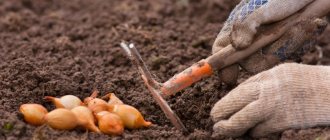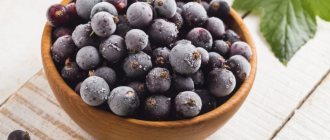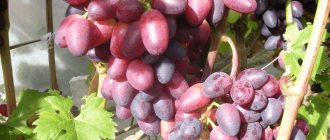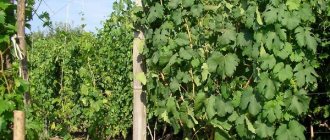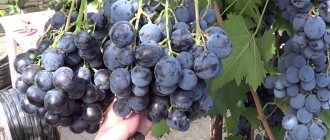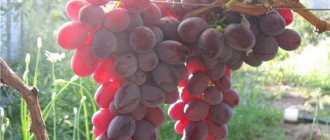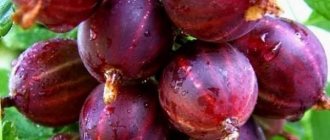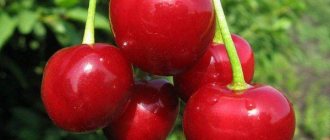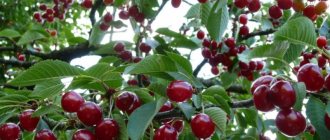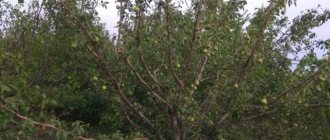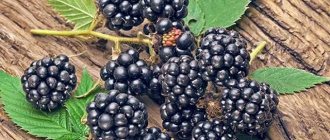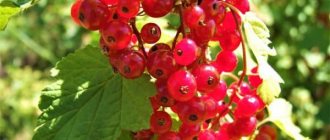Botanical description
Hercules is a bush variety with straight-growing, medium-density bushes. Young shoots are green with a slight pink tint, medium thickness or thick. Old shoots become woody, become light brown with a weak shine and a slight coating.
The buds are single, small, located in groups at the top of the shoots, and have a light green color with a pink tint. The leaves of this variety are dense, smooth, large, and three-lobed. Bright green color. The petioles of the leaves are thick, of medium length, pubescent, and light green in color.
The flowers of the plant are medium-sized, open, cream-colored with a pink border. The brushes are long, one per node, green in color with slight pubescence. The peduncles are medium-sized, short, the pubescence is weak. The berries are large, round, black, have a slight shine and a light coating. The skin is thin and quite elastic. Inside the berries there are many small seeds of a light brown color. The berry peel is dry. The calyx is medium, falling.
Did you know? Unripe currant berries contain 4 times more active vitamin C than ripe ones; when overripe, the amount of vitamins in the berry decreases.
Description of the variety
Currant bushes of the Yadrenaya variety are characterized by restrained growth.
They reach a height of only 1.5 meters.
Young growing shoots have an average thickness, although they can grow quite thick. The color of the bark is standard green, with a faint anthocyanin blush appearing here and there. The pubescence is weak.
Lignified adult currant shoots differ from young ones mainly in the color of the bark - from light to dark brown.
The buds are medium-sized, apical, deviated, collected in groups of 1-3 in each node. Their shape is ovoid with a pointed tip. The color is bright red, the pubescence is weak.
The leaves have a standard five-lobed shape, are shiny, leathery, dark green, slightly wrinkled and vesicular. There is no pubescence on the leaves, the veins are deeply depressed. The main veins have a dark pink tint. The teeth are wide, of medium length, and curved. Cream dots are clearly visible on them. The leaf petioles are medium in length and thickness, pink in color, and have slight pubescence.
The flowers are medium-sized, pale pink. The brushes are elongated in length so that they contain from 6 to 12 loosely closed berries.
The stalks are thick, long, pubescent, and hold clusters of berries well on the bushes.
Black currant Yadrenaya is a late-ripening variety in terms of ripening time. Its berries begin to ripen only towards the end of July, and in some regions even in August. Fruiting occurs in a fairly short time, which is especially beneficial for farmers for industrial cultivation.
The variety shows good resistance to both frosty winters (it can tolerate down to -30°C without shelter, and with good snow cover - up to -40°C), as well as extreme heat and drought, which makes it suitable for cultivation in many regions.
The early fruitfulness of this currant also deserves attention - already in the first year after planting it can bear a harvest, but the branches of the 2nd and 3rd year of fruiting are the most abundant in terms of the number of fruits.
The yield of the Yadrenaya currant variety deserves admiration - up to 5-6 kg of berries can be harvested from one bush. When grown on an industrial scale, this figure varies between 6 to 12 tons of berries per hectare and depends on agricultural technology, planting density and plant age.
Currant variety Yadrenaya is also characterized by good resistance to powdery mildew and bud mite. True, susceptibility to anthracnose is only about 3 points.
Characteristics of berries
The black currant berries of the Yadrenaya variety break all records in size and are considered practically the largest, if we consider the varieties of domestic selection as a comparison.
- The shape of the berries is round, sometimes slightly oblong, as if plum-shaped.
- The berry sizes reach 2 cm in length and 1.5 cm in width. Many people confuse the berries of this currant with grapes or cherries.
- The weight of one berry can reach up to 8 g, the average weight is 5-7 grams. Usually the berries are well balanced in size and weight.
- The flesh is fleshy, the skin is thin but durable. The berries contain a significant amount of fairly large seeds.
- The color of the fruit is black, without intense gloss.
- After being torn off, the berries do not leak juice, and after picking with brushes they may not fall off for a long time.
- Currant berries of this variety have an amazing aroma and sweet and sour taste. According to tasters, the taste quality is rated at 4.3 points. Many people consider the taste of Yadrenaya berries to be downright sour, but if you have the opportunity to let them hang on the bushes after ripening, do so. And you will be able to appreciate their taste.
- The berries contain: sugars – 9%, ascorbic acid – 96 mg/100g, dry soluble substances – 8-11%, titratable acidity – 3.7%.
- The use of berries is universal. It is best to freeze them for the winter or grind them with sugar to preserve all the vitamins. But they will also look luxurious in various compotes, jellies, preserves, jams, etc.
- The transportability of the berries is low. It is better to transport them only short distances.
Characteristic
This variety has gained wide popularity due to its good characteristics.
Drought resistance, frost resistance
The variety, bred in Siberia, is distinguished by excellent winter hardiness; it is able to survive even severe frosts without shelter. At the same time, the plant does not like heat, but loves a lot of sun. In cloudy, rainy summers, berries will accumulate the least amount of nutrients.
Productivity and fruiting
The variety has good yield; during the season you can collect about 3.5–4 kg of berries from each bush. If we consider the yield on an industrial scale, it is believed that up to 11 tons of fruits can be collected per hectare of land. The variety is late, but this does not affect the ripening of the harvest; there are the same number of berries from season to season, they are large in size.
Advantages and disadvantages
- The obvious advantages of the plant include:
- high yields in both northern and southern regions;
- good taste;
- self-fertility;
- large fruits that can easily withstand transportation over long distances and long-term storage;
- high cold and frost resistance;
- immunity to fungal diseases;
- unpretentiousness to the type of soil;
- easy to care for, it is recommended to be planted by novice gardeners.
The main and almost only disadvantage of the variety is its instability to infection with bud mites.
Berry size, taste
Currant Hercules bears fruit with large and very large berries. Their weight can vary between 1.5–3.5 g. The fruits are also distinguished by good taste: sweet and sour in taste, the berries are considered dessert. It is also good to make jams and preserves from them.
Video: Currant Hercules
Characteristics of the Hercules variety
Also check out these articles
- Estonian quail
- Onion sets - varieties, planting and care
- Sow farrowing pen
- Plumeria flower
Black currant Hercules photo
The Hercules blackcurrant variety gained its popularity due to its quality characteristics.
- Although the variety is late, the harvest yield is good, so gardeners rarely complain about the ripening of berries.
- Hercules currant is self-fertile.
- Mechanical picking of berries is possible.
- Thanks to the dry tearing of the berries and the rather dense peel, Hercules currants can be transported over long distances without significant damage.
- The taste is dessert, sweet and sour. Contains 18.4% dry matter, 8.7% sugars, 2.2% titratable acids. Vitamin C in 100 g is about 177 mg.
- This is a winter-hardy variety. It is easy to grow in the southern and middle regions, but insulation is desirable in the northern regions.
- Hercules currant is resistant to anthracnose and septoria.
- Productivity is high and stable. Approximately 11.1 tons of crop are harvested per hectare.
Among the disadvantages, there is susceptibility to the effects of kidney mites. This pest requires regular treatments!
Landing Features
Despite the unpretentiousness of this variety, it has some planting features on which the harvest will depend. But even inexperienced gardeners will not find it difficult to plant at least a couple of bushes of this currant on their plot.
Deadlines
Hercules can be planted in both autumn and spring. However, the microclimate should be taken into account: in regions where spring begins early and summer is quite hot, plants that do not have time to take root well often die from the heat. Then it is better to plant in the fall.
Important! If frosts begin, it is also better to postpone planting, otherwise fragile seedlings may die.
Conditions
To breed Hercules, it is necessary to observe certain conditions for planting seedlings. Prepare the holes in the garden bed at a distance of at least a meter, otherwise the plants will start to hurt. If you are going to plant bushes in several rows, then increase the distance between the seedlings even more.
The holes for planting are prepared in advance (possibly two months before planting), then the soil will have time to “settle”, which will have a positive effect on the development of plants. The depth of the holes should be about 30–40 cm. Fertilizers (compost, manure) can be added to the bottom.
Choosing a suitable location
Currants love sunny areas and enough moisture, but at the same time they really do not like areas blown by the wind. Therefore, when choosing a site, it is better to stop at a place where you can build a fence that will protect the seedlings from drafts and wind. Also keep in mind that moisture should not stagnate in the area, otherwise it is worth installing a drainage system to remove excess moisture. If the soil is too acidic, water the soil with lime milk to get rid of it.
Did you know? Currants contain a large amount of pectin and ascorbic acid, which is why they are recommended for nutrition for those who work in hazardous industries, especially those with radiation.
Selection and preparation of seedlings
When selecting seedlings, be sure to carefully examine their roots, making sure that there are no spots or other signs of disease on them. Seedlings should have at least 2-3 shoots. A healthy seedling has 3–5 skeletal yellow-brown roots 15–20 cm long. Healthy currants also have thread-like shoots. It is better to plant purchased seedlings immediately .
Landing algorithm
The landing itself is simple:
- Place the seedlings in pre-dug holes (maintain an angle of 45°).
- Water the holes thoroughly.
- Add soil there and mix.
- Deepen the plants into the ground 5–10 cm.
- Finally, prune the branches, leaving half the original length (this renews the crown and promotes root growth).
Video: Planting black currants
Agrotechnical techniques
Any black currant, be it Russian or foreign selection, cannot be called a problem-free crop. Growing chokeberries has its own characteristics and nuances. Quite often you can hear complaints from farmers about the lack of survival and capriciousness of this crop.
Advice! Hercules is perfect as a first experiment - it is one of the most unpretentious varieties.
In order for a currant bush to take root and produce good harvests every year, it must first be planted correctly. And subsequently - provide competent care.
Time and place of landing
In principle, black currants can be planted in both spring and autumn. In most Russian regions, spring is early and summer is quite hot. In such conditions, fragile spring seedlings often disappear and die from heat and drought. Therefore, Hercules is best planted in the fall: from the beginning of September to the second ten days of October.
Attention! If autumn frosts have begun in the region, it is better to postpone planting currants until spring and dig in the seedlings.
For normal development, black currants need sun and sufficient air. Therefore, a place for planting Hercules should be chosen in an open, sunny area.
Despite the unpretentiousness of the variety to the composition of the soil, it is still recommended to avoid excessive soil acidity. In such cases, before planting, the soil can be watered with lime milk or other deoxidation methods can be used.
It is necessary to choose the interval between neighboring bushes taking into account the height of Hercules. This is a tall plant, and although the currant shoots are erect and not prone to lodging, the distance between the bushes should be decent. If the shadow from an overgrown bush falls on neighboring plants, fungal infections of currants and the spread of mites cannot be avoided.
Advice! The optimal distance between Hercules bushes is 1.5-2 meters. If the bushes are planted in several rows, the interval needs to be increased a little more. The most important thing is to maintain normal ventilation of the bushes.
Planting process
Late Hercules can be planted both in holes and in trenches. The depth of the holes should be 30-40 cm. Experienced gardeners recommend preparing planting holes for currants in advance - at least a couple of months before planting. This will allow the earth to compact and settle, which will have a beneficial effect on the currants planted later.
Fertilizers must be placed at the bottom of the planting holes. It can be humus, compost, horse manure, humus. Organic matter can be mixed with wood ash or mineral phosphorus-potassium fertilizers. Sprinkle some soil on top and begin planting currants.
Important! If the acidity of the soil is high, add a handful of chalk or dolomite flour to the planting hole.
Many gardeners note better survival rate of black currants when planting bushes at an angle. In this case, the seedling is placed at an angle of 45 degrees to the horizontal. This way the roots of Hercules will grow faster, the currant will take root and grow.
Even before the roots are covered with soil, water is poured into the hole. Only after this they begin to compact the soil and fill the planting hole with soil. To rejuvenate the crown and direct the strength of the currant to the roots, the shoots of the bush are cut by a third or half.
Shrub pruning
There is nothing complicated in the subsequent cultivation of Hercules black currant; it requires the same care as any other variety. The most important condition for high yield and long “life” of the plant is proper pruning.
It is recommended to prune currants twice a year: in spring and autumn. Spring pruning should be done until the buds swell on the branches. In autumn, Hercules is pruned between the last harvest and the first serious frost.
The rules for pruning black currants are as follows:
- All shoots are cut down to the ground or to a larger branch - there should be no stumps left.
- Those shoots that lie on the ground or are located close to its surface must be cut out. Otherwise, they can cause infection of the bush.
- All diseased, dry and old shoots older than five years must be removed.
- From the young shoots, only the erect and largest shoots should be left; crooked and weak branches should be cut out.
- By the age of five, the currant bush should consist of three old shoots, three two-year-old and three young branches. There should not be more than 12-15 shoots on one bush.
Attention! In addition to regular pruning, Hercules requires loosening the soil, removing weeds, watering, fertilizing and preventive treatments.
Care
To obtain a high-quality harvest, it is important to provide the currants with the necessary conditions and proper care. It is imperative to loosen the soil. Excessively compacted soil inhibits plant development, which leads to a decrease in the quantity and quality of the harvest. Only the top layer of soil is loosened so as not to damage the roots of the plant. It is better to loosen after watering.
Read the information on why you need to whiten a currant bush.
Watering is required abundantly, but it is better not to overdo it; 3-4 times per season will be enough, the last one necessarily after fruiting, so that the plants regain their strength.
The bush can take the rest of the moisture from natural precipitation. Pruning also needs to be done regularly, then the bushes grow better. In addition, pest prevention is carried out in this way. Usually the bushes are pruned before the buds appear (April), or in the fall, when the harvest is harvested, but before the onset of frost.
When pruning, follow several rules:
- cut shoots level with the ground, without leaving protruding sprouts;
- cut off diseased, deformed, damaged and too old shoots;
- Also cut off branches that fall too close to the ground;
- annually remove a couple of old shoots to rejuvenate the bush.
If you prune the bush correctly, there should be about 15 branches left. Currants should be fed when planting, and then from 3 years from the moment of planting. Apply 1 tbsp under each bush. l. superphosphate and potassium sulfate per 10 liters of water. This type of feeding is performed twice a season.
Fig.1. Pruning currants_ a - one-year-old seedling; b - two-year-old bush; c, d - shortening of shoots. Fig.2. Currant bush before anti-aging pruning (a), after it (b) and pruning of a neglected bush (c).
Planting currants
Seedlings (cuttings) are planted to a depth of 10 cm
Hercules currants should be planted in a well-lit place where there is no lack of light. On the one hand, it is desirable to have natural protection from the wind. Stagnation of water at the planting site is unacceptable, but if there is no other option, drainage is arranged during planting. As for the type of soil, there are no particular preferences.
Important!
Important!
To avoid feeding the bushes in the first two years, fertilized soil is used for planting. Add humus (a bucket), ash (100 g), superphosphate (75 g) and potassium sulfate (35 g) into plain soil (2 buckets).
Seedlings (cuttings) are planted to a depth of 10 cm and then cut off by 2/3. If a bush is planted, then a hole about 50 cm deep is dug under it. Drainage is poured onto the bottom, then the bush is placed and covered with earth on all sides. There should be at least a meter of free space between seedlings.
Preparing for winter
Hercules is cold-resistant, however, it is better to cover the bushes in the winter. First, the shoots need to be bent to the ground in the direction of their growth and grouped in 3-5 pieces, then a board is laid on top and a brick on it. The tree trunk circle is sprinkled with rotted sawdust, leaves or sunflower husks. This way you will protect the bushes from frost and maintain moisture in the soil. After snow falls, transfer the material to the branches and lightly press down. If snow has not fallen, cover the bush with spruce branches of a coniferous tree or agrofibre.
Video: Preparing currant bushes for winter
What kind of care does the variety require?
Each variety of black currant, bred in a hybrid way, requires similar techniques that make up the care of the crop. But for each variety there are several distinctive requirements regarding the irrigation schedule, shaping or tying rules.
Irrigation
The summer resident is intolerant to drought, so regular watering is a mandatory requirement for caring for the hybrid. During the flowering and fruiting period, an adult bush needs 2 buckets of warm water weekly. Watering is carried out in a circle near the trunk in order not to wash out the soil from under the trunks.
During dry, hot summer days, it is recommended to water the Dachnitsa currant variety with evening drip sprinkling. This method moisturizes the foliage and shoots.
Feeding bushes
The application of fertilizers to improve fruiting rates is mandatory when caring for the Dachnitsa variety:
- When laying buds, before flowering, nitrogen-containing complexes are added to the soil, these include ammonium nitrate and complex fertilizers.
- When fruits form and berries ripen, calcium and phosphorus are added to the soil; these can be dry granules or solutions of mixtures based on the main elements.
Loosening, mulching the soil
It is recommended to mulch the soil around the currants after planting. To do this, use larch bark or pine needles. Larch bark has bactericidal properties, which helps prevent soil diseases, as well as the appearance of parasitic insects.
Causes and treatment of white plaque on currant leaves, how to treat and how to fight
Read
Loosening is carried out after each heavy watering or prolonged rain. This helps provide the soil with additional air and does not interfere with the growth of the root system, which depends on the condition of the top layer of soil.
Formative pruning
Bushes of the Dachnitsa variety have a compact size. They are pruned in spring and autumn:
- In spring, damaged, dead branches that cannot adapt are removed.
- In the fall, bushes are pruned to prepare for wintering.
In addition, in summer pruning can be corrective in nature. This means that shoots are removed that block access to the sun for the main part of the plant.
Cold protection
Despite the fact that the variety has high frost resistance, in regions with possible low air temperatures in winter, the bushes are additionally covered. Newly planted seedlings that have not reached two years of age are also covered.
The bushes are pruned to 4-5 buds, then carefully bent to the ground and covered with agrofibre or burlap. To prevent the material from unfolding from strong winds, it is secured with twine or nylon rope. The tree trunk circle is loosened, a protective trench is made, and the soil around the trunk is mulched.
Diseases and pests - treatment and prevention
The Dachnitsa variety is resistant to powdery mildew and spider mites. The main threat to this species is anthracnose. This fungal disease can destroy the season's harvest. Infection occurs in stages: first the root system is affected, then the condition of the above-ground part gradually worsens.
Currants are often colonized by aphid colonies, which cause leaves to curl, turn yellow, dry out, and fall off. For aphids, systematic treatments are carried out with tobacco or soap solutions. They help to completely get rid of adult individuals and destroy their clutches.
Reproduction methods
The most popular and convenient methods of propagating currants are vegetative. The easiest of them is propagation by layering. To do this, in early spring, find a branch no more than 2 years old that can be tilted down without damaging it. Under the selected branch, dig a hole 10–12 cm deep and bend the branch down so that its middle part is in the hole, and the top protrudes above the ground.
Don't forget to water the branch thoroughly. Over the summer it will grow into a powerful seedling, then it can be cut off from the parent bush. Then you can transplant the branch to the garden bed.
Propagation by lignified cuttings allows you to harvest seedlings even during winter frosts. To do this, at the end of autumn, branches are cut (cut on both sides) 18–20 cm long. Be sure to cut them before the onset of severe frosts. Cuttings are cut from annual shoots on 2-3 year old branches. It is better to cut them from the middle of the shoot, where it is 8–10 cm thick. Then treat the sections with warm paraffin or garden varnish.
You may be interested in how to tie currants.
Wrap the cuttings in moistened paper, then in plastic. Before planting, they should be stored by burying them in the snow or placing them in the refrigerator. In the spring, plant the cuttings in the beds, maintaining a distance of 15 cm. Before planting, the tip of the cutting is cut off, leaving an oblique cut.
When planting cuttings, two buds are left on the surface. Then water the beds thoroughly. Place arcs 40–50 cm high over the beds and cover with plastic film. You can remove it when the first leaves appear, then start watering the beds. In the fall you will receive seedlings 30–50 cm long with 1-2 shoots, then you can plant them in the garden bed.
Propagation by green cuttings is a longer and more energy-consuming process; its implementation requires a greenhouse or hotbed with a fog-forming function. Cuttings 5–10 cm long are cut from well-developed shoots, and two green leaves are left on each of them. It is advisable to immerse the base of the cuttings in a liquid growth stimulator for 12–14 hours. During the process, do not forget to ensure that the humidity level is high and the temperature is +18...+24°C.
Important! The roots of the planted cuttings are still weak, so they must be constantly watered.
You can also prepare cuttings for planting currants from the last winter month. Place the cut cuttings in water and wait until the roots grow to a length of 10–12 mm. Next, transplant the cuttings into bags with soil, after making holes at the bottom for water drainage. The cuttings should be watered generously every 2-3 days. When 10 days have passed after placing the seedlings in the bag, reduce watering to normal. By the beginning of May, the seedlings reach half a meter in height; they need to be planted 10–15 cm deeper than they were in the ground in bags.
Video: How to root currant cuttings in water
Agricultural technology and care
The black currant as such has its own specifics in terms of cultivation and care. Despite the fact that Hercules currant, according to the description of the variety, is a plant of moderate whimsicality, in order to get a decent harvest, you will need to work hard.
Landing
Black currant Katyusha
Planting currant crops is possible both in spring and autumn. Most Russians prefer to engage in this type of work before the start of winter, after harvesting. As a rule, we are talking about the end of September and beginning of October.
Important! For normal growth and development, black currant Hercules needs sun and air, so it is strongly recommended to choose an open and unshaded area for planting.
Despite the fact that the crop is not too picky about the soil, acidic soil should still be avoided. Reducing the acidity of the soil is not difficult - just treat the planting site with lime milk.
The optimal distance between Hercules currant bushes should be from one and a half to two meters. If the crop is planted in several rows, the indicated distance should be further increased.
The variety can be planted in holes or trenches with a depth of at least 30 cm. It is recommended to prepare planting holes in advance: at least two months in advance. This time should be enough for the earth to settle and compact.
Fertilizers, mostly organic, are placed at the bottom of the planting holes. It is allowed to mix organic matter (manure, humus or humus) with phosphorus-potassium additives. The top dressing is lightly sprinkled with soil and the bushes themselves are planted directly on top.
Interesting. Summer residents who continue to garden and grow all kinds of crops for many years note the fact that Hercules blackcurrant takes root much better if the seedling is positioned at an angle of 45 degrees relative to the horizon. This placement of the bushes accelerates the development of the root system, and the currants begin to quickly gain strength and growth.
Watering
Another significant point in caring for Hercules blackcurrant is watering. It is especially important not to forget to carry out this procedure before the crop begins to flower and during the period of fruit ripening. Watering should be carried out in such a way that moisture does not get on the stems and foliage. If they remain wet frequently, the risk of developing powdery mildew is high. On average, it is enough to water currants once a week.
Hercules currants need regular watering, but you shouldn’t overwater them.
Trimming
Proper pruning of a bush is a kind of guarantee that the plant will grow well throughout the entire season, and upon its completion will produce an excellent harvest. The event is held twice a year: in the spring, when the buds on the plant have not yet begun to swell, and in the fall, before frost.
Pruning is carried out in compliance with the following simple rules:
- cut shoots either to the root or to the largest branch;
- shoots lying on the ground must be pruned, as they can become a source of infection of the plant;
- it is necessary to prune all old, diseased and dry shoots;
- Only large and healthy shoots should be left from young shoots.
As a result, by the fifth year of its life, the shrub should have 3 old shoots, 3 two-year-old shoots and the same number of young ones. In total, after pruning, you should not leave more than 15 shoots on the plant.
Currant pruning
Loosening
Black currant Hercules requires soil that has good air permeability, so the loosening process is vital. Too compacted soil at the planting site significantly slows down the development and growth of the plant, which, in turn, negatively affects the quality characteristics of the crop. Loosening the soil should be done at the surface. If you go too deep, there is a high risk of damage to the root system. It is close to the soil surface. The soil should be loosened after watering.
Top dressing
Black currant Hercules especially urgently needs feeding in the spring. Nitrogen-based formulations are optimal for fertilizer.
As for autumn feeding, in this case about 5 kg of compost should be placed under each bush, as well as a small amount of potassium sulfate and superphosphate. Most often, gardeners use ready-made mixtures of organic fertilizers for fertilizing.
In some cases, fertilizing currants may be required in the summer. For example, if the plant is not actively growing, blooming or setting fruit. A solution of cow manure diluted in water in a ratio of 1:10 will help solve the problem. One ten-liter bucket will be enough per square meter of planting.
Diseases and pests
Hercules currants are not affected by anthracnose and septoria. In general, this currant is susceptible to few diseases and parasites, and by following some rules for their prevention, you will get rid of them for good.
- Kidney mite - a small insect that overwinters inside plant buds. With the onset of warmth, the pest wakes up. Females lay eggs inside young buds, which later stop their development because of this. Signs of the presence of a mite on a bush are curliness and marbling. Infected buds resemble cabbage due to severe swelling. Methods of pest control include manual removal of affected buds, treatment with boiling water or special preparations. To prevent plant infection by bud mites, it is necessary to carry out sanitary pruning in a timely manner, plant only healthy seedlings, and timely removal of weeds from the beds.
- Currant glass - the larvae develop inside the stem of the plant, creating tunnels there, as a result of which the berries dry out and the leaves turn yellow. You can fight it only with the help of drugs such as Fitoverm or Lepidocid. Prevention - timely pruning of affected shoots.
- Currant borer - the parasite, settling on a bush, slowly eats the stems of the plant. The eggs are laid on the surface of the branches, while clinging to them with mucus. Due to the activity of the pest, the plant weakens. The control method will be to remove the affected branches and treat them with calcium arsenic acid. The essence of preventing borer infection is proper and thorough care.
Advantages and disadvantages of the Hercules currant variety
Many gardeners speak positively about Hercules blackcurrant. I am especially pleased with their good yield and berry size.
Black currant variety Hercules is unpretentious, it can be grown on different soils if they are fertile
pros
- high and stable yield;
- good frost resistance;
- large fruits;
- ease of care;
- long-term storage;
- resistance to most fungal diseases;
- high content of ascorbic and fruit acids;
- self-fertility;
- transportability.
Minuses
- vulnerability to kidney mite.
Harvesting and storage
In order for the harvest to be stored for a long time, it is important to follow the rules of proper berry picking. If you want to use the berries right now, you can pick them at any time. But if the berry is going to be stored, then it must be collected in dry weather, after the dew has disappeared. Pick the berries in tassels as carefully as possible. Place the berries in small baskets, preferably their width is greater than their height, so that the berries will not be damaged under their own weight.
Fresh berries can be stored in the refrigerator for up to two weeks; if you pick slightly unripe berries, their shelf life will increase, during which time they will have time to ripen. Never wash berries before placing them in the refrigerator.
If for some reason the berries get wet, they must be dried before storing. For storage, the berries are placed in an unsealed container so that air circulates between them. In addition, currants make excellent preserves, and the berries lend themselves well to freezing.
With proper care, Hercules blackcurrant will bring you large harvests of excellent taste and quality. You can easily grow this variety of currant in your own area.
general information
Black currant Hercules is a fairly young variety, developed by breeders of the Siberian All-Russian Scientific Research Institute at the end of the 20th century. This is a large-fruited, high-yielding and late variety, the fruits of which are rich in beneficial nutrients.
Currant Hercules will become a real decoration of any garden plot
The plant is suitable for cultivation in almost all regions of the country, except the northernmost. In the conditions of the far north, currants often simply do not have time to ripen during a short period of heat, so they are planted infrequently.
The variety belongs to the dessert variety, but the Hercules berry is no less good when eaten fresh.
Hercules berries are very large
It should be noted! Currants, in principle, belong to crops whose fruits are mainly used for processing: preserves, jams, freezing, etc.
The Hercules variety is the most unpretentious variety of currant. In this regard, it is excellent for planting even by the most inexperienced gardeners. The variety demonstrates itself no worse as an industrial planting. The berries are easily picked by automated machines.
Landing rules
Hercules raspberries are planted in spring and autumn. With early spring planting, the root system quickly forms, the above-ground part grows rapidly, and within 3 months the harvest ripens. It is planted when the air temperature does not drop to sub-zero levels during the week. But during spring planting, all the plant’s forces will be directed to survival and development of the root system, so the harvest will be smaller. The best time for rooting seedlings is autumn (late September - early October), when it is still warm enough and raspberries will have time to take root in 20-30 days before the onset of cold weather, and will develop intensively in the spring.
The best time to plant raspberries is autumn
Site selection
The wrong choice of location for a raspberry plant often leads to the death of plants. It is necessary to allocate elevated sunny areas for raspberries, preferably in the southern part of the garden. When grown in the shade, the yield decreases. Lowlands are contraindicated - in the spring the soil thaws there for a long time, during prolonged summer rains water accumulates, the roots rot, and the plants are exposed to fungal infections.
The raspberry plant should be located in a place protected from the wind
The area for the raspberry garden should be well heated by the sun and protected from the wind by a fence, other plantings, and outbuildings. Remontant raspberries grow on any soil, but prefer slightly acidic, loose and fertile soils. It does not tolerate an acidic environment, so dolomite and lime are added to the soil. Raspberries are replanted every 8–10 years. It can be returned to its original place in 5–7 years.
It is not advisable to plant grapes, sea buckthorn, or parsley next to a raspberry tree - growing these crops together has a bad effect on their growth and productivity. A good neighborhood - cucumbers, onions, carrots, red currants, apple trees, cherries.
Selection of seedlings
You should not buy seedlings at the markets - you may buy the wrong variety or diseased bushes. They should be purchased only in specialized stores or garden centers, where the plants are controlled and have certificates containing information about the variety. Seedlings should have a developed fibrous root system, with many thin roots. Growths or blackening indicate disease. Shoots should be free of dark spots and mold.
The seedling must have healthy flexible roots without spots or growths
Site preparation
The site is prepared in advance, 2–3 weeks before planting. Per 1 m² add 2 buckets of humus, 50 g of superphosphate, 30 g of potassium nitrate. After applying the fertilizer, the soil is dug up and loosened. Holes 60 cm wide and 45 cm deep are dug at intervals of 1 m.
It is better to plant raspberries in trenches at a distance of 1.5 m between rows and 70 cm between bushes. The rows are arranged from north to south for better illumination and warming by the sun. Trenches are dug 50 cm wide and 45 cm deep. When planting, rotted manure is added to the bottom in a 5 cm layer, 200 g of superphosphate, 70 g of potassium salt, 300 g of ash per 1 m2 and mixed with the fertile layer of soil.
It is more convenient to plant raspberries using the trench method
Step by step process
Before planting, plant roots can be kept in Kornevin solution for several hours for better rooting and disease prevention.
- The seedling is lowered to the level of the root neck - to a depth of 6–7 cm, and the roots are straightened.
- They fill it with earth, leaving no voids, and compact it.
- Water - at least 5 liters per bush.
- Shorten shoots to 25–30 cm.
- Mulch the tree trunk circle with dry hay, humus, sawdust, and onion peels in a layer of 10 cm.
Caring for Hercules currants
Proper care of black currants
Black currant Hercules is unpretentious, but for a large harvest you need to provide it with proper care.
Loosening the soil and removing weeds are regular procedures that should not be neglected. Conducted as needed.
Watering is needed abundantly, but not frequently. 3 waterings per season are more than enough. The first - at the end of May - early June, when the green mass is growing, the second - at the end of June - when the fruits ripen and the third - after fruiting, to restore the strength of the bush. Otherwise, natural precipitation will suffice.
To prevent water from quickly evaporating, the bushes can be mulched with peat or compost. Mown grass is also suitable as an alternative.
Fertilizing is applied from 3 years after planting. Take 1 tbsp under the bush. a spoonful of superphosphate and the same amount of potassium sulfate per 10 liters of water. This feeding is carried out 2 times per season - during the period of ovary emergence and after harvesting.
Gardeners recommend pruning annually or even twice a year. Thinning pruning increases the yield and resistance of the bush to infections. The pagons are cut right next to the ground so that there are no stumps. If a branch spreads along the ground, it should also be removed so as not to get in the way. Only strong, erect shoots are left, which can produce a large harvest. If the pruning is for rejuvenation, you need to remove 2-3 of the oldest branches from the bush and leave the rest. On average there should be about 15 branches on a bush. If there are more of them, you can thin out the bush by removing younger pagons.
In case of disease or pests, the bushes are treated with specialized means.
The harvest is harvested after ripening. This currant is universal and can be used in any form.
Description of raspberry Hercules
This variety was developed by Russian breeder I.V. Kazakov, crossing Ottom Bliz and No. 14-205-4.
Hercules is a remontant variety - in one growing season it gives 2 harvests: in July (fruits form on last year's stems) and in August (berries ripen on young shoots).
The bushes are slightly spreading. They reach a height of two meters. The shoots are powerful and the fruits do not tilt them down. Therefore, there is no need to use trellises. Young stems are green, while those that have reached the age of one year acquire a purple color and a waxy coating. The stems are completely covered with thorns.
The size of the berries matches their name. The average weight is 6-10 grams, but some specimens reach 15 grams. They are cone-shaped and painted a bright ruby color. The fruits are dense but juicy, have a pleasant sweet and sour taste and a pronounced raspberry aroma. Taste qualities are rated 4 points.
2.5-4 kilograms of berries are harvested from one bush. When harvesting, you should use a small container to avoid crushing the delicate berries.
This variety is successfully grown in both home and industrial gardens.
Unlike most other remontant varieties, Hercules produces a large amount of shoots that can be used for propagation.
You can plant seedlings in any soil. But they prefer sandy or loamy soil, characterized by weak acidity.
For a raspberry garden, you should choose a well-lit area, protected from drafts, in the southern part of the site. It may get dark in the morning.
Seedlings are planted in the spring (April-May), before the buds begin to open, or in the fall (September-October), when the growing season ends.
Holes for planting (50x50 centimeters) should be prepared in advance (3 weeks). The third part of the holes is filled with a soil mixture to which humus (10 kilograms), superphosphate (20 grams) and potassium sulfate (80 grams) are added.
The seedlings are placed in holes and covered with earth, pressing it down well so that no voids form. The root collar should be located 3-5 centimeters above the soil surface. The bush is watered and mulched using compost or peat.
Plants are planted at a distance of 80 centimeters from each other. The optimal distance between rows is one and a half meters.
You can also propagate raspberries by cuttings. Before planting, the cuttings are sprinkled with charcoal. Plant them in containers and water them regularly. After the cuttings take root (this process takes about a month), they are transplanted to a permanent place.
To prevent the roots from spreading throughout the area, the raspberry tree is fenced off.
Fertilizers are applied 3 times per season:
- in May, when the berries appear;
- in July, when fruiting begins;
- in August-September, when buds are laid for the future harvest.
In the spring, a solution of mullein (half a liter per bucket of water) or dry ammonium sulfate is added under the bush.
In summer, plants are sprayed with a solution prepared from superphosphate, potassium sulfate, urea and boric acid.
In autumn, superphosphate and potassium salt or humus are added to the soil.
Proper pruning allows you to regulate the number of fruitings. In autumn, the tops of young shoots are cut off, and two-year-old stems are cut at the root. Damaged and dry shoots are also removed.
Some gardeners cut out all the stems at the root. In this case, the raspberries will give only one harvest, but it will be of higher quality.
Hercules does not require special care. It is enough to regularly destroy weeds, loosen the soil, water and feed the plants. But if you pay more attention to raspberries, their yield will increase significantly.
It is recommended to regularly thin out the raspberry tree by cutting out the shoots. Otherwise, the yield will decrease and the fruits will be crushed.
Hercules is drought tolerant and can survive without watering. But to significantly increase the yield, raspberries are watered at the end of May, twice in June and July, at the beginning of August and in October. It is best to make furrows between the rows for watering. But you can also use sprinkling.
Loosening the soil is required to ensure the supply of oxygen to it. The first time weeding is done before the buds begin to bloom. Then the procedure is repeated when weeds appear or a crust forms.
To reduce the number of weedings, it is recommended to mulch the soil with humus, peat compost or sawdust.
For winter, the shoots are bent to the ground and covered with leaves or sawdust.
Reviews of Hercules currant
Popular blackcurrant variety Hercules
Many gardeners know about the Hercules variety. For some it is a favorite, for others it is simply one of many grown on the site. Below are reviews from gardeners who have been growing this variety on their plots for several years.
Marina Bondarenko
: “I have known this currant for many years now - fertile, unpretentious, resistant to disease. In my memory, pests appeared on the bushes a couple of times, but there were no diseases, so I recommend it to everyone!”
Maxim Shevchenko
: “For my grandchildren, the Hercules variety is the most favorite. The rest of the bushes that grow in the garden are somehow not to their liking, too sour, but not this one. The berries are tasty, sweet, I often make preserves or compotes from it for the winter. Useful even after freezing.”
Roman Tatur
: “The Hercules blackcurrant variety is easy to care for. I didn’t do it at all for a couple of years, but the harvests were large. In the third year, I fed the bushes and pruned them, as they had grown so much. In general, I am more than satisfied! This is the best choice for young gardeners.”
